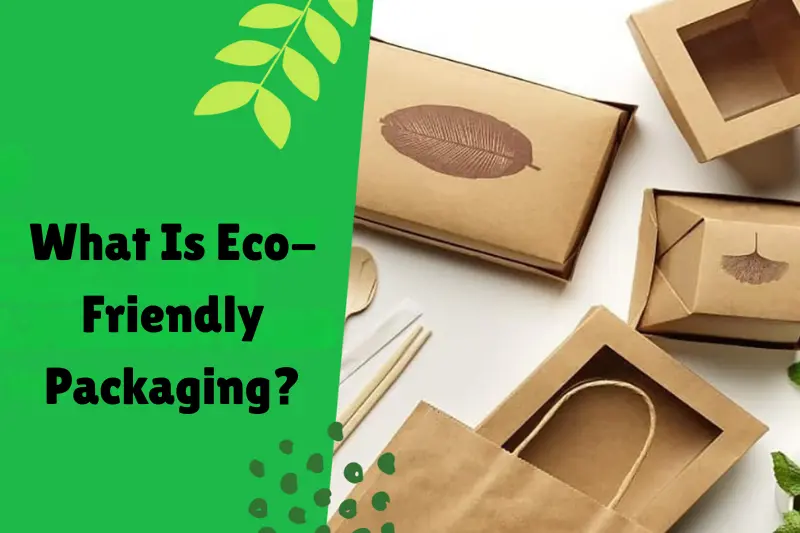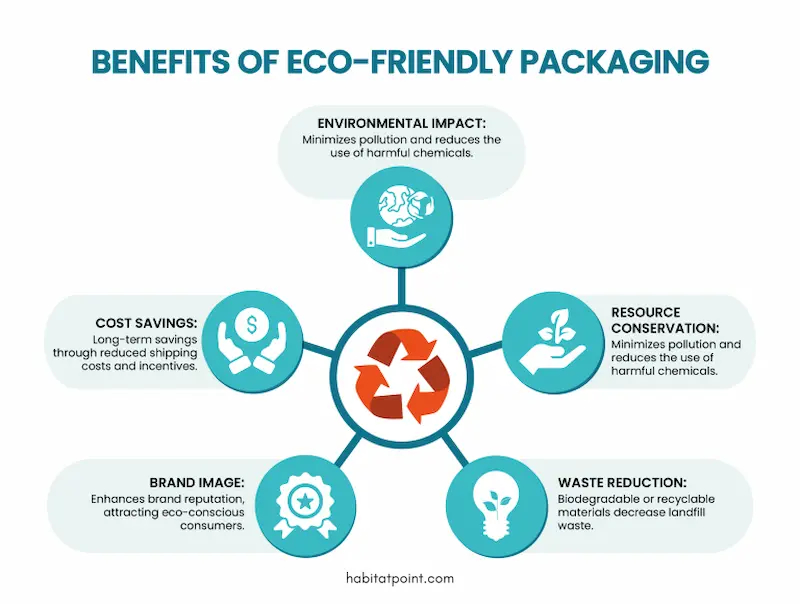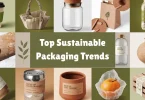We live in a world where convenience often comes at a cost—and that cost is the health of our planet. Think about everyday items: plastic bottles, takeaway cups, or delivery boxes. Many people wonder how eco-friendly packaging works and why it’s so important today. Every year, the world produces over 381 million tonnes of plastic, with half being single-use, and 1 million plastic bags are thrown away every minute, polluting oceans and landfills.
The good news? Businesses now have solutions like compostable cups, recycled boxes, and plant-based wraps that protect products without harming the planet. Let’s explore how eco-friendly packaging works and why it matters in simple, practical steps.
What Is Eco-Friendly Packaging?

At its core, eco-friendly packaging is all about designing packaging materials that do their job—protecting products—without harming the planet. Traditional packaging, especially plastic, can take hundreds of years to break down, leaking toxic chemicals into soil and water. Eco-packaging, on the other hand, uses sustainable, recyclable, compostable, or biodegradable materials.
It’s not just about being trendy or slapping a “green” label on a box. It’s about minimizing waste, reducing carbon footprints, and giving customers the peace of mind that their purchase doesn’t come at the cost of the environment.
How Eco-Friendly Packaging Works
So, how does eco-friendly packaging work in practice? It focuses on rethinking materials, design, and production so that packaging protects the planet as much as it protects your product.
Here are the main ways it works:
1. Using Materials That Break Down Naturally
Unlike plastics that linger for centuries, eco-friendly packaging uses materials that either biodegrade or can be safely recycled. Examples include:
- Bioplastics made from renewable resources like corn starch, sugarcane, or potato starch.
- Plant-based fibers such as bamboo, hemp, or palm leaves, which decompose quickly.
- Recycled paper and cardboard, which can be reused again and again.
These materials ensure that, when discarded, the packaging returns to nature instead of polluting it.
2. Reducing Carbon Footprints
One major benefit of eco-friendly packaging is its role in fighting climate change. Traditional packaging often requires large amounts of energy to produce, transport, and dispose of. Lightweight, biodegradable alternatives reduce:
- Fuel use during shipping (lighter loads = fewer emissions).
- Energy in production, since recycled materials often require less processing.
This means every product shipped in eco-packaging leaves behind a smaller carbon footprint.
3. Designed for Recycling and Reuse
A big part of how eco-friendly packaging works is designing with the end in mind. Instead of packaging that ends up in the trash, many eco-packaging solutions are either recyclable or reusable.
- Recyclable packaging: Cardboard boxes, glass jars, and aluminum containers that can be reprocessed.
- Reusable packaging: Cloth shopping bags, refillable bottles, or durable pouches designed to be used multiple times.
This cycle of reuse and recycling keeps materials out of landfills and oceans.
4. Water- and Energy-Efficient Production
Eco-friendly packaging doesn’t just reduce waste—it also considers the resources used in making it. For instance:
- Recycled cardboard requires far less water and energy to produce than virgin plastic.
- Innovations like mushroom packaging (grown from mycelium) need very little energy and water to create.
By consuming fewer natural resources during manufacturing, eco-friendly packaging minimizes overall environmental impact.
5. Customer-Centric Sustainability
One of the smartest aspects of how eco-friendly packaging works is its consumer appeal. More than ever, shoppers want their purchases to align with their values. Studies show that consumers are more likely to choose brands with sustainable packaging—and they’re willing to pay more for it.
This means businesses adopting eco-friendly packaging aren’t just “doing good,” they’re also:
- Building brand loyalty.
- Attracting eco-conscious customers.
- Staying ahead of government regulations banning single-use plastics.
It’s a win-win for both the planet and business growth.
Benefits of Eco-Friendly Packaging

Switching to eco-friendly packaging isn’t just about being environmentally conscious—it also brings practical, economic, and social advantages for businesses, consumers, and the planet. Let’s explore the key benefits:
1. Reduces Environmental Impact
Eco-friendly packaging is made from sustainable, biodegradable, or recyclable materials, which reduces plastic pollution, landfill waste, and greenhouse gas emissions. By choosing eco-packaging, businesses directly contribute to a cleaner and healthier planet.
2. Conserves Natural Resources
Traditional packaging often relies on virgin plastics, petroleum, and excessive energy. Eco-friendly alternatives use renewable resources and recycled materials, conserving water, energy, and raw materials in the process.
3. Supports a Circular Economy
Eco-packaging is designed for recycling, composting, or reuse, helping create a closed-loop system. This reduces waste, minimizes environmental footprint, and encourages sustainable consumption.
4. Boosts Brand Reputation
Consumers today care deeply about sustainability. Brands that adopt eco-friendly packaging are seen as responsible, modern, and customer-focused, which builds trust, loyalty, and positive brand perception.
5. Attracts Eco-Conscious Customers
Studies show that a growing number of consumers actively choose products with sustainable packaging. Using eco-friendly packaging can therefore increase sales, attract new customers, and retain existing ones.
6. Future-Proofs Against Regulations
With governments worldwide regulating single-use plastics and promoting sustainable alternatives, eco-friendly packaging helps companies stay compliant, avoid penalties, and prepare for future regulations.
7. Encourages Innovation
Transitioning to sustainable packaging pushes businesses to innovate in materials, design, and processes, opening opportunities for creative, functional, and cost-effective solutions.
8. Reduces Carbon Footprint
Eco-friendly packaging often uses lighter, renewable materials and energy-efficient production, which lowers emissions during manufacturing and transportation. This contributes to a smaller overall carbon footprint.
9. Promotes Consumer Awareness and Responsibility
By using eco-friendly packaging, businesses educate and encourage consumers to adopt sustainable practices like recycling, composting, and reuse. This creates a shared effort toward environmental conservation.
10. Economic Advantages in the Long Run
Although initial costs may be higher, sustainable packaging often reduces waste disposal costs, attracts loyal customers, and opens new markets, providing long-term economic benefits.
You may also like to read this:
Types of Food Trends In 2026: What’s Hot on Your Plate
Why Clean Eating Is More Than A Trend | Complete Guide
Top Best Trending Snacks In The Market For Snack Lovers
Top Future Food Innovations To Watch For Smarter Eating
What Is Smart Food Packaging? Everything You Should Know
Why Businesses Should Care
Switching to eco-friendly packaging is more than an environmental gesture—it’s a business strategy. Here’s why:
- Regulations are tightening: Many countries are phasing out single-use plastics, so adapting now saves future costs.
- Brand reputation: Sustainable practices enhance brand image.
- Consumer demand: Surveys show customers actively seek eco-conscious brands.
Ignoring eco-friendly packaging risks losing customers and facing penalties, while adopting it sets businesses apart.
Examples of Eco-Friendly Packaging in Action
Let’s look at how industries are already embracing eco-friendly packaging:
- Food Industry: Compostable coffee cups, edible spoons, and biodegradable takeaway containers made from sugarcane or cornstarch.
- Fashion Industry: Brands using recycled paper bags, cloth packaging, and tags made from seed paper that can actually grow into plants.
- E-commerce: Companies replacing plastic bubble wrap with corrugated cardboard, paper-based tape, and recycled boxes.
These changes prove that eco-friendly packaging is not only practical—it’s happening right now.
The Bigger Picture
At the heart of it, how eco-friendly packaging works is about making small changes that lead to a big impact. By replacing harmful materials with sustainable alternatives, reducing carbon emissions, and promoting reuse, eco-packaging helps:
- Keep plastics out of oceans.
- Reduce landfill waste.
- Conserve energy and water.
- Create a cleaner, healthier planet for future generations.
It’s proof that something as simple as the box, bag, or cup we use every day can shape the world in powerful ways.
Future of Eco-Friendly Packaging
Eco-friendly packaging is already reshaping industries, but it’s only the beginning. As technology evolves and sustainability becomes an even greater priority, we can expect to see:
- Smart Sustainable Packaging: Combining eco-friendly materials with smart sensors to monitor freshness, reduce food waste, and track supply chains.
- Edible Packaging Innovations: Expanding beyond spoons and cups into wrappers made from seaweed or rice paper that you can eat instead of throw away.
- Circular Economy Models: Brands creating take-back programs where packaging is collected, cleaned, and reused, closing the loop entirely.
- Government-Led Bans and Incentives: More regions banning single-use plastics while offering tax breaks or credits to companies adopting green packaging.
The future shows us that eco-packaging won’t just be an option—it will become the global standard.
Challenges of Eco-Friendly Packaging
Of course, no solution is perfect. Understanding the challenges is part of appreciating how eco-friendly packaging works in the real world.
- Higher Initial Costs
Sustainable materials and innovative designs often cost more to produce than cheap plastic. But as demand grows, economies of scale are driving costs down. - Limited Infrastructure
Not every city or country has proper recycling or composting systems in place, which can limit the effectiveness of eco-friendly packaging. - Consumer Awareness
Many people still don’t know how to properly dispose of biodegradable or compostable packaging. Education is crucial. - Performance Issues
Sometimes eco-friendly materials may not match the durability or moisture resistance of traditional plastics. Ongoing innovation is tackling these concerns.
How You Can Support Eco-Friendly Packaging
It’s not just up to businesses—consumers have power too. Here’s how you can play your part:
- Choose brands that prioritize eco-friendly packaging.
- Reuse packaging whenever possible—turn jars into storage or reuse sturdy boxes.
- Learn how to dispose of biodegradable and compostable packaging correctly.
- Advocate for change by supporting regulations that reduce single-use plastics.
Remember: every purchase is a vote. By choosing eco-conscious brands, you encourage others to follow suit.
Why This Matters Now More Than Ever
We’re living in a defining moment. Scientists warn that if plastic pollution continues at its current pace, by 2050 there could be more plastic in the ocean than fish. That chilling prediction highlights just how urgent the switch to sustainable solutions really is.
Eco-friendly packaging works because it addresses the problem at the source. It replaces harmful materials, reduces energy use, and ensures that packaging doesn’t just serve the product—but also serves the planet.
Final Thoughts
So, when we ask, how eco-friendly packaging works, the answer is bigger than just materials or design. It’s a system—one that rethinks production, supply chains, consumer habits, and waste management.
- For businesses, it’s a chance to innovate, attract loyal customers, and stay ahead of regulations.
- For consumers, it’s a way to make meaningful choices with every purchase.
- For the planet, it’s a crucial step toward restoring balance and reducing pollution.
Eco-friendly packaging isn’t just a trend—it’s the future. And the more we embrace it today, the more sustainable, livable, and hopeful our tomorrow will be.
FAQs
1. What is the most eco-friendly packaging material?
Materials like biodegradable plastics made from cornstarch, recycled cardboard, paper, bamboo, and hemp fibers are among the most eco-friendly. They decompose quickly, require fewer resources to produce, and can often be recycled or composted.
2. Is eco-friendly packaging more expensive?
Initially, sustainable materials may cost more than traditional plastics. However, as demand increases and production scales up, costs are dropping. Many businesses find that the long-term benefits—brand loyalty, regulatory compliance, and reduced environmental impact—outweigh the initial expense.
3. Can all eco-friendly packaging be recycled?
Not necessarily. Some materials are biodegradable but not recyclable, while others are recyclable but not compostable. Consumers should check packaging labels and follow local recycling guidelines to ensure proper disposal.
4. How can businesses make the switch to eco-friendly packaging?
Businesses can start by:
Assessing current packaging for environmental impact.
Switching to recycled, compostable, or plant-based materials.
Designing packaging for reuse or minimal waste.
Educating consumers on proper disposal.
5. Does eco-friendly packaging really make a difference?
Absolutely. Small changes at scale can significantly reduce landfill waste, plastic pollution in oceans, and carbon emissions from production and transportation. Over time, widespread adoption can transform entire industries.




